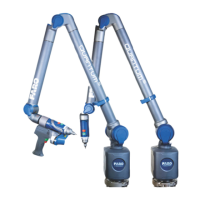FaroArm® Quantum
August 2017
121
Chapter 6: Maintenance and Troubleshooting
the counterbalancing mechanism. The reaction forces will result in deformations
in the mounting, which degrade the performance of the Quantum if the
deformations are sufficiently large.
The primary forces encountered due to counterbalancing are translation and
torsion. These forces are illustrated in
Figure 6-1, Figure 6-2, and Figure 6-3. The
forces can be further described along or about the three major axes of a
coordinate system at the mounting base. The translation forces (F) along the axes
and the moments (M) about the axes result in deformations of the base.
The deformation due to the translation force can be measured. You must apply
forces (lb. or N) using a calibrated load cell at the mounting interface to the
maximum level required and measure the associated deformation (in. or mm).
The torsional forces or moments at the base are generated by using a calibrated
torque wrench. The deformations can be described as a slope (in./in. or mm/mm)
and can be measured. The deformations must not exceed the deformation
reported at calibration.
In general, the excessive translation deformations are added directly to the
certified accuracy, while the excessive angular deformations of the base affect
accuracy as a more complicated trigonometric function of the length of the reach.
Figure 6-1 Forces Encountered due to
Counterbalancing
Figure 6-3 Displacement due to Force
Figure 6-2 Rotation due to Torque
&9
9
-
9
-X
-OMENTSABOUT8
8&
8&ORCESALONG8
-
:
:
&
:
&ORCE
$ISPLACEMENT
DUETO&ORCE
$
,
$
$
2OTATIONDUETO4ORQUE
,
4
08m80e00_FaroArm_Quantum.book Page 121 Tuesday, August 22, 2017 11:03 AM

